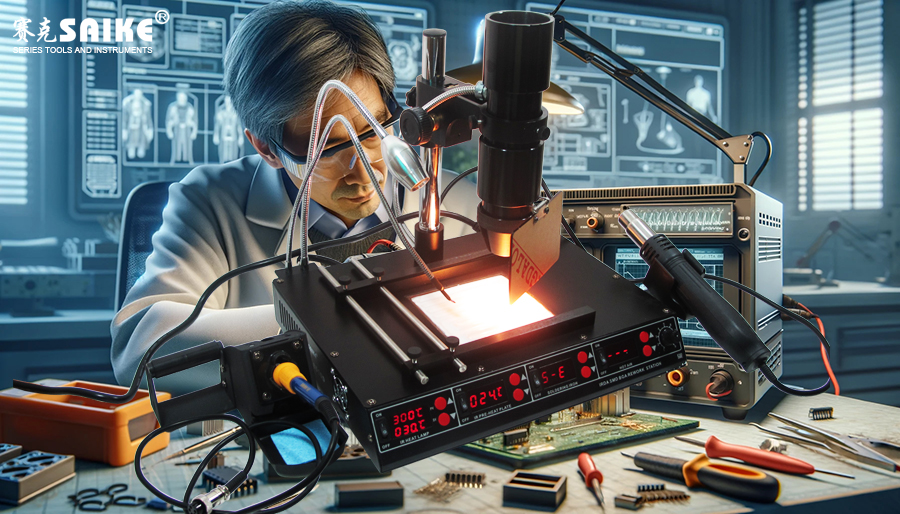
SK-YJ000HWXCHT-KP 100018
As a precise electronic repair and manufacturing tool, the infrared desoldering station requires regular maintenance and inspection to ensure stable and efficient operation of the equipment. This article will introduce the regular maintenance and inspection steps of the infrared desoldering station in detail, including maintenance points for heating elements, temperature control, sensors, electrical systems, and other key components, to help users extend the service life of the equipment and improve work quality.
I. Maintenance and Inspection of the Heating System
1.Infrared Emitter:
– Visual Inspection: Regularly inspect the appearance of the infrared emitter lamp to ensure there are no cracks, damage, or burn marks.
– Resistance Test: Use a multimeter to measure the resistance value of the emitter to ensure it is within the standard range.
– Lamp Replacement: If the lamp shows signs of aging, damage, or abnormal resistance, it should be replaced with a new one promptly.
2.Reflector and Lens:
– Cleaning the Reflector: Clean dust, oil, and oxides from the reflector, lens, or reflective plate to ensure the thermal efficiency of the infrared emitter.
– Angle Adjustment: Ensure that the reflector or lens is positioned at the correct angle to concentrate infrared radiation on the target area.
II. Maintenance and Calibration of the Temperature Control System
1.Temperature Sensor:
– Sensor Calibration: Regularly calibrate the infrared or thermocouple sensor to ensure accurate temperature feedback.
– Connection Inspection: Check the connection between the sensor and the control system to ensure secure wiring without corrosion or loosening.
2.PID Controller:
– Parameter Adjustment: Adjust PID control parameters based on the actual usage of the equipment to ensure fast and stable heating response.
– Software Updates: Check and update the firmware or software of the PID controller to avoid operational anomalies.
III. Inspection of the Control Panel and Operating System
1.Control Panel:
– Button Test: Test the buttons and knobs on the control panel to ensure responsiveness and smooth operation.
– Display Inspection: Check the temperature, power, and time display data on the screen for accuracy and clarity.
2.Operating System:
– Firmware Upgrade: Check and upgrade the firmware of the operating system to ensure stability and security.
– Data Backup: Regularly back up temperature curves and operational data to prevent data loss during system resets or failures.
IV. Maintenance of the Electrical and Ventilation Systems
1.Electrical System:
– Power Cord Inspection: Check the power cord and plug for integrity to avoid breakage or poor contact.
– Internal Circuit Board: Inspect the circuit board and wiring to ensure all connections are secure and show no signs of short circuits or burning.
2.Ventilation and Smoke Exhaust:
– Fan Cleaning: Clean the cooling fan and heatsink to ensure the proper functioning of the ventilation system and prevent overheating.
– Smoke Exhaust Pipe: Inspect and clean the smoke exhaust pipe to ensure smooth removal of smoke and gases generated during welding and desoldering processes.
V. Routine Operations and Protective Measures
1.Regular Maintenance Logs:
– Establish maintenance logs to record the time, content, and identified issues during each maintenance session for easy tracking of equipment status.
2.Protective Measures:
– Static Protection: Use an anti-static workbench and wristband to prevent electrostatic damage to circuit boards and electronic components.
– Overheating Protection: Ensure the equipment’s overheating protection function is operational to prevent accidental damage to the device or components.
VI. Summary
Regular maintenance and inspection of the infrared desoldering station are crucial to ensure efficient and safe equipment operation. By checking and cleaning the heating system, temperature control, control panel, electrical system, and ventilation system, the equipment’s lifespan can be effectively extended, improving the quality and efficiency of electronic repair and manufacturing. Implementing maintenance logs and protective measures further ensures the equipment is in good working order, reducing the risk of equipment failure and damage.


